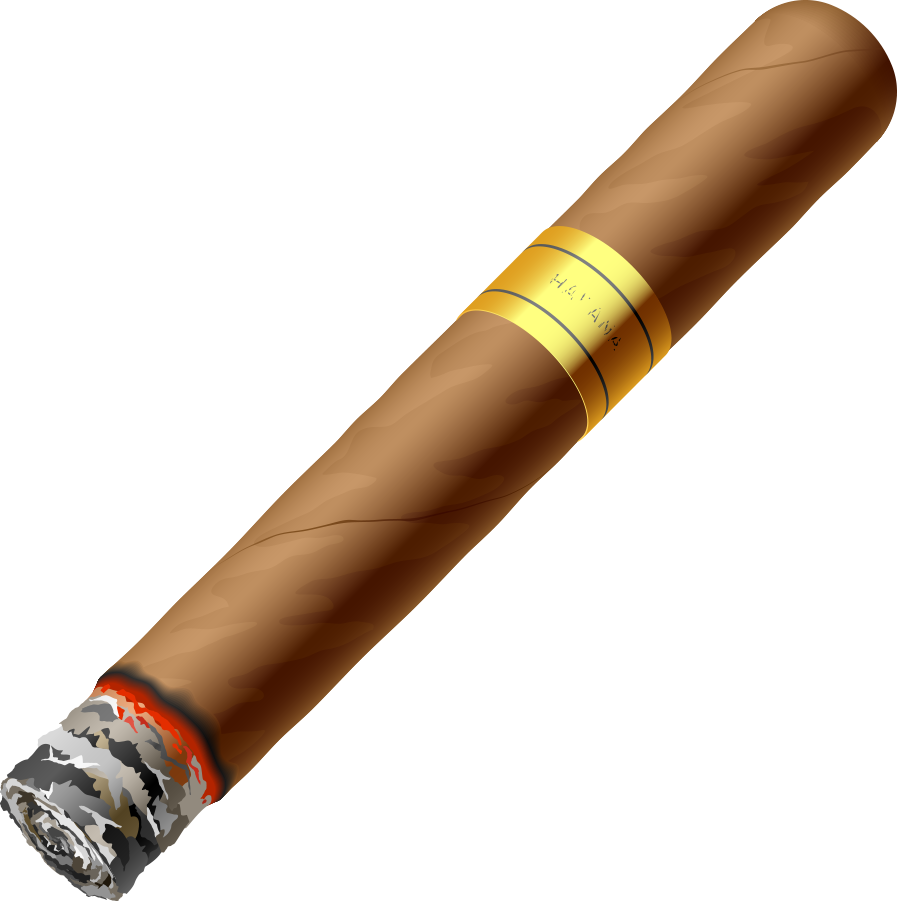
This image has format transparent PNG with resolution 897x901.
You can download this image in best resolution from this page and use it for design and web design.
Cigar PNG with transparent background you can download for free, just click on download button.
A cigar is a rolled bundle of dried and fermented tobacco leaves made to be smoked. Cigars are produced in a variety of sizes and shapes. Since the 20th century, almost all cigars are made of three distinct components: the filler, the binder leaf which holds the filler together, and a wrapper leaf, which is often the highest quality leaf used. Often there will be a cigar band printed with the cigar manufacturer's logo. Modern cigars can come with two bands, especially Cuban cigars, showing Limited Edition (Edición Limitada) bands displaying the year of production.
Cigar tobacco is grown in significant quantities primarily in Central America and the islands of the Caribbean, including Cuba, the Dominican Republic, Haiti, Honduras, Mexico, Ecuador, Nicaragua, Guatemala, Costa Rica, Panama, and Puerto Rico; it is also produced in the Eastern United States, Brazil and in the Mediterranean countries of Italy, Spain (in the Canary Islands), and Greece and in Indonesia and the Philippines of Southeast Asia.
Cigar smoking carries serious health risks, including increased risk of developing various types and subtypes of cancers, respiratory diseases, cardiovascular diseases, cerebrovascular diseases, periodontal diseases, teeth decay and loss, and malignant diseases.
Two firms dominate the cigar industry, Altadis and the Scandinavian Tobacco Group.
Altadis, a Spanish-owned private concern, produces cigars in the US, the Dominican Republic, and Honduras, and owns a 50% stake in Corporación Habanos S.A., the state owned national Cuban tobacco company. It also makes cigarettes. The Scandinavian Tobacco Group produces cigars in the Dominican Republic, Honduras, Nicaragua, Indonesia, the Netherlands, Belgium, Denmark and the United States; it also makes pipe tobacco and fine cut tobacco. The Group includes General Cigar Co.
The town of Tamboril in Santiago, Dominican Republic is considered by many as today's "Cigar Capital of the World" housing more cigar factories and rollers than anywhere else in the world. According to Cigar Aficionado magazine, 44% of the world's most traded cigars come from the Dominican Republic, the world's largest producer of cigars, especially from the fertile lands of the Cibao capital, where 90% of the factories are located. The area has also been the largest supplier of cigars to the US in the last decades.
Pure tobacco, hand rolled cigars are marketed via advertisements, product placement in movies and other media, sporting events, cigar-friendly magazines such as Cigar Aficionado, and cigar dinners. Since handmade cigars are a premium product with a hefty price, advertisements often include depictions of affluence, sensual imagery, and explicit or implied celebrity endorsement.
Cigar Aficionado, launched in 1992, presents cigars as symbols of a successful lifestyle, and is a major conduit of advertisements that do not conform to the tobacco industry's voluntary advertisement restrictions since 1965, such as a restriction not to associate smoking with glamour. The magazine also presents pro-smoking arguments at length, and argues that cigars are safer than cigarettes, since they do not have the thousands of chemical additives that cigarette manufactures add to the cutting floor scraps of tobacco used as cigarette filler. The publication also presents arguments that risks are a part of daily life and that (contrary to the evidence discussed in Health effects) cigar smoking has health benefits, that moderation eliminates most or all health risk, and that cigar smokers live to old age, that health research is flawed, and that several health-research results support claims of safety. Like its competitor Smoke, Cigar Aficionado differs from marketing vehicles used for other tobacco products in that it makes cigars the main (but not sole) focus of the magazine, creating a symbiosis between product and lifestyle.
In the US, cigars have historically been exempt from many of the marketing regulations that govern cigarettes. For example, the Public Health Cigarette Smoking Act of 1970 exempted cigars from its advertising ban, and cigar ads, unlike cigarette ads, need not mention health risks. As of 2007, cigars were taxed far less than cigarettes, so much so that in many US states, a pack of little cigars cost less than half as much as a pack of cigarettes. It is illegal for minors to purchase cigars and other tobacco products in the US, but laws are unevenly enforced: a 2000 study found that three-quarters of web cigar sites allowed minors to purchase them.
In 2009, the US Family Smoking Prevention and Tobacco Control Act provided the Food and Drug Administration regulatory authority over the manufacturing, distribution, and marketing of cigarettes, roll-your-own tobacco and smokeless tobacco. In 2016, a deeming rule extended the FDA's authority to additional tobacco products including cigars, e-cigarettes and hookah. The objective of the law is to reduce the impact of tobacco on public health by preventing Americans from starting to use tobacco products, encourage current users to quit, and decrease the harms of tobacco product use.
In the US, inexpensive cigars are sold in convenience stores, gas stations, grocery stores, and pharmacies. Premium cigars are sold in tobacconists, cigar bars, and other specialized establishments. Some cigar stores are part of chains, which have varied in size: in the US, United Cigar Stores was one of only three outstanding examples of national chains in the early 1920s, the others being A&P and Woolworth's. Non-traditional outlets for cigars include hotel shops, restaurants, vending machines and the Internet.
In this page you can download free PNG images: Cigar PNG images free download